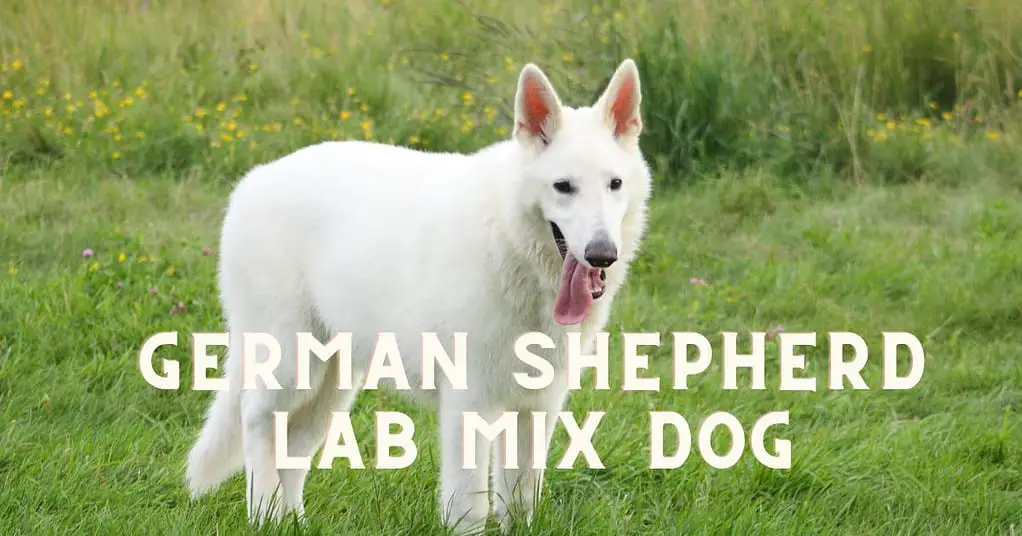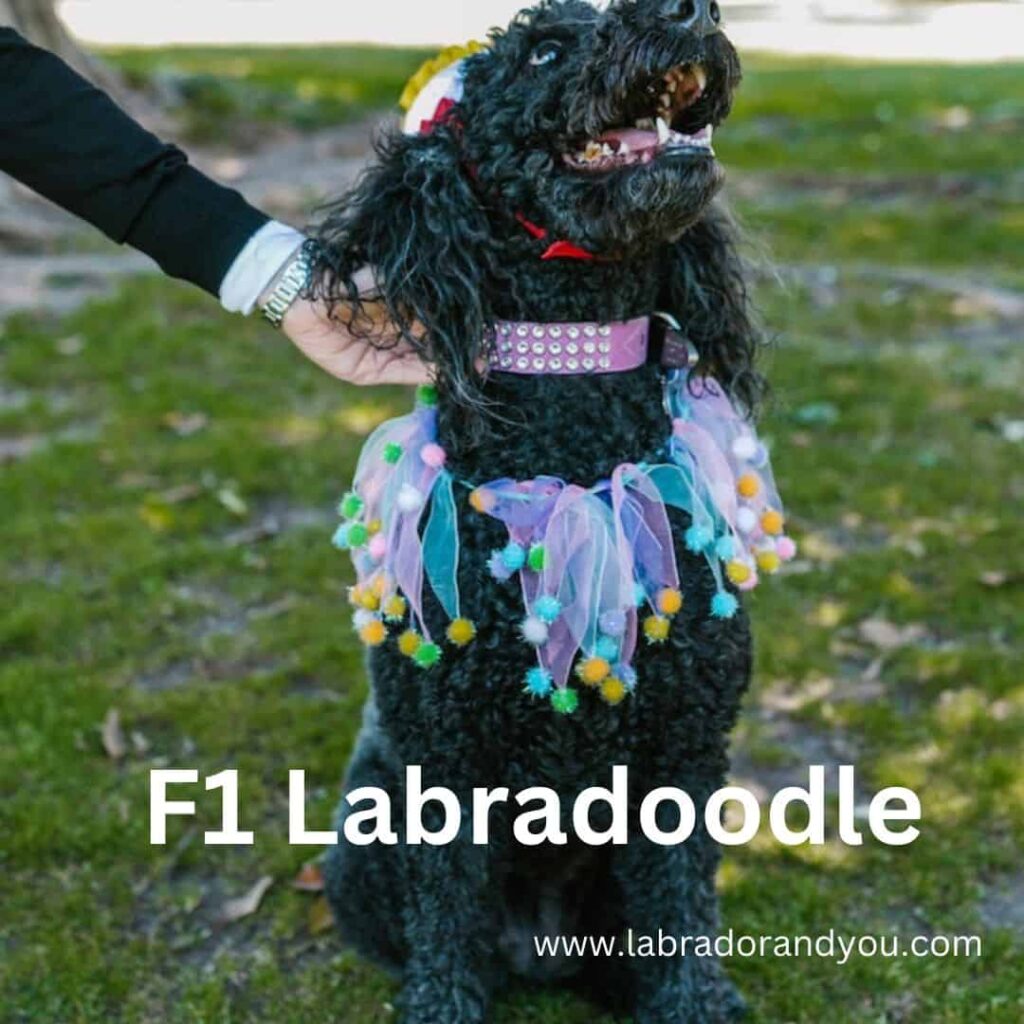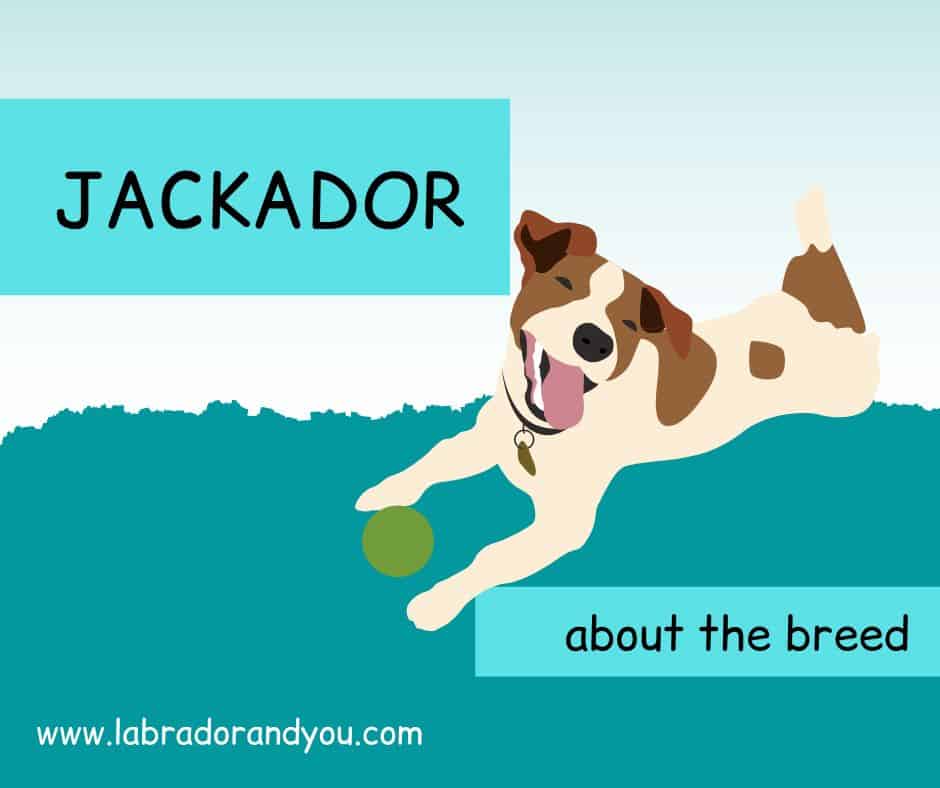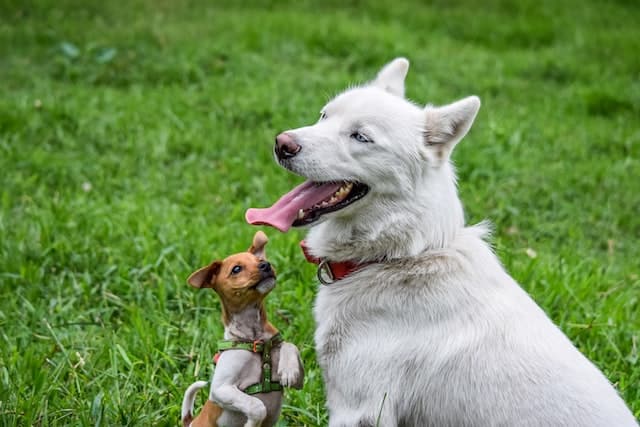The Mastiff Lab Mix is a hybrid dog breed known for its gentle, giant personality. This breed is a cross between the Mastiff and the Labrador Retriever, two of the most popular dog breeds in the world. Also, Mastiff Lab Mix is recognized by the Dog Registry of America and the International Designer Canine Registry.
Mastiff Lab Mixes are large dogs weighing anywhere from 80 to 150 pounds. They have short, dense coats in various colors, including black, brown, white, and brindle. These dogs are known for their gentle demeanor and their love of people. They are also very intelligent and easy to train.
What Is A Mastiff Lab Mix?
The Mastiff Labrador Mix is a popular designer breed resulting from crossbreeding. Let’s learn more about this mixed-breed dog’s purebred parent breeds.

Overview Of The Mastiff Lab Mix Puppy
The Mastador is an intriguing mixed breed. These giant dogs inherit their parent breeds’ best qualities. They are excellent family companions, skilled guard dogs, and adept hunting partners.
Mastiff Labrador Retriever Mix has adaptable personalities that help them thrive in bustling city apartments to sprawling countryside estates. Their low sensitivity level allows them to handle noisy households filled with activity while remaining calm and composed.
History And Origins
The Lab Mastiff Mix originated in the United States and was first bred in the 1990s.
Mastiff Breed History
The Mastiff, a majestic and ancient breed, has its roots in the distant past. Originating over 5,000 years ago in Asia and Africa, these gentle giants were primarily bred for power and strength.
They served as war dogs for powerful civilizations like the Egyptians, Greeks, Persians, and Romans. Often described as “gentle giants,” Mastiffs are known for their striking size and calm demeanor.
Throughout their history, roles included hunting large game such as bears or wolves. They served as guard dogs on English estates. Mastiff breeds participated in bloodsports like bull-baiting until these events were banned during the early 19th century.
The Mastiff parent has undergone significant changes through selective breeding over time but remains true to their noble yet versatile nature. They are ready to act protectively while offering affectionate companionship within family households.
Labrador Retriever Breed History
The Labrador Retriever has a fascinating history that can be traced back to the early 19th century in Newfoundland, Canada. Fishermen in this region originally bred these dogs for their impeccable work ethic and inherent swimming abilities.
In the early 1800s, British sportsmen took note of the impressive skills displayed by these dogs during a visit to Canada. They were so enamored by their intelligence and trainability that they imported the labrador retriever puppy back to England. Once on British soil, these dogs were selectively bred with local retrievers to create what we now know today as the purebred Labrador Retriever.
Physical Characteristics Of The Mastiff Labrador Mix
The Lab Mastiff Mix is a dog breed with a short, thick coat that comes in various colors and patterns.
mastiff and lab mix: Size And Weight
The Lab Mastiff Mix is a giant hybrid breed that can weigh between 85 to 160 pounds. It stands 28 to 36 inches at the shoulder, with males larger than females. Their massive size makes them an impressive sight, but they also require plenty of indoor and outdoor space.
However, their size can make them challenging for novice dog owners who may be unprepared for their strength or energy levels.

mastiff labrador mix: Coat Color And Patterns
The Lab Mastiff Mix can have a coat that matches the parent breeds’ coats and colors. The main colors for these dog breeds are brown, black, yellow, and brindle. Some Mastador mixed breed dogs have a black mask if their coat color is light or brindle. They can also have white chests and paws.
Regular grooming is required for these large dogs with moderate shedding potential. Keep an eye out for debris that may get caught in floppy ears, which raises the chances of infections.
labrador mastiff: Temperament And Personality Traits
The Mastiff Lab Mixed breed is known for having an affectionate and calm personality. It makes them great family dogs.
Mastador Mixed Breed Temperament
The Labrador Mastiff Mix inherits its temperament from their Mastiff and Labrador Retriever parents. They are affectionate and gentle, making them suitable for families with children or other dogs. This mixed-breed dog love to play and interact with humans. They thrive in households where people are around most of the time.
Despite their size and strength, the mixed breed has a low sensitivity level. They can handle noise or chaos without getting overwhelmed. They are highly adaptable to different living spaces. However, regular exercise is needed to maintain Mastiff and Labrador health.
Proper training is essential for these dogs. While they respond well to positive reinforcement techniques, they need early socialization. It will help them become comfortable around strangers or unfamiliar situations.
Interaction With Children And Other Pets
Lab Mastiff dog breeds are excellent family pets. They have a friendly personality, love to play, and show affection to their owners. If properly trained and socialized, the Lab Mastiff pup gets along well with other dogs. Due to their size, the dog owner must supervise interactions between the Mastiff Lab Mix puppy and small children or pets.

Training A Mastiff Lab Mix
Early socialization is crucial for Mastiff Lab Mixes to ensure they develop into well-rounded pets.
Importance Of Early Socialization For Mastiff Lab
Proper socialization is essential for your Mastador pup to avoid any issues with aggression or fearfulness. Starting early, exposing your dog to various sights, sounds, and experiences can help them become well-adjusted adults.
Mastador dog is intelligent but needs specific training techniques due to their size and strength. Socializing your lab mastiff mix also means positive reinforcement training that encourages good behavior while discouraging bad behavior.
Training Techniques
Training your Mastiff Lab Mix puppy should be gradual and based on positive reinforcement. Here are some helpful tips for training your new furry friend:
- Use positive reinforcement techniques like treats, toys, or affection to motivate and reward good behavior.
- Avoid using punishment or physical force during training sessions.
- Start obedience training early to establish yourself as the pack leader.
- Be consistent with commands and use a firm but gentle tone of voice.
- Socialize your mixed breed puppy with strangers, other pets, and children to reduce fear or aggression.
- Use plenty of repetition during training sessions to help reinforce commands and behaviors.
- Keep training sessions short (about 15 – 20 minutes) to avoid overwhelming your puppy.
- Use a designated area for potty training and reward them when they go to the right place.
- Gradually increase exercise time as your Labrador Mastiff Mix ages to prevent destructive behavior due to boredom or pent-up energy.
- Consider enrolling in puppy classes with a professional trainer to enhance socialization and learn more advanced obedience skills.
Remember that every dog is unique, so it is essential to adapt your training methods accordingly.
Health Concerns
Labrador Mastiff Mix is prone to certain health issues like obesity, gastric dilation volvulus (bloat), and elbow and hip dysplasia. They can cause discomfort and pain if not addressed promptly.
Common Health Problems
The older Mastiff Lab Mix is susceptible to various health issues that affect both English Mastiff and Labrador Retrievers. Awareness of these health problems and taking preventive measures before they escalate is essential. Here are some common health problems found in these designer dogs –
- Hip dysplasia: An inherited condition that affects the hip joints, causing discomfort and eventually leading to arthritis.
- Elbow dysplasia: A genetic disorder that affects the elbow joint, leading to pain, lameness, and arthritis.
- Cataracts: A clouding of the eye’s lens, affecting vision in one or both eyes.
- Retinal Dysplasia: An inherited eye disorder that can lead to partial or complete blindness.
- Gastric Dilatation Volvulus (GDV) or Bloat: A life-threatening condition where the stomach twists and fills up with gas, cutting off the blood supply.
- Obesity may lead to severe health concerns such as heart disease, diabetes, and joint problems if not managed correctly.
Regular checkups with a trusted veterinarian can help diagnose these conditions early on. Proper nutrition, exercise regimen, dental care, and grooming practices help maintain good overall health.
Lifespan
These mixed breeds have a lifespan of 10 to 15 years. They are prone to various health issues that affect their quality of life. In addition to scheduled vet visits, proper nutrition is vital in keeping these large dog breeds healthy. Raw dog food diets can provide the nutrients for optimal health and prevent obesity.
Owners should also make sure that they get enough exercise daily. Physical activity plays a crucial role in their overall happiness and longevity.

Caring For A Mastiff Lab Mix
To ensure the health and well-being of this popular dog breed, maintain a regular grooming routine. Besides, provide them with the right nutrition and exercise.
Grooming Requirements
This designer dog has a moderate to low shedding coat that needs regular brushing. Here are some grooming requirements to keep your hybrid dog healthy and clean:
- Brush their coat once or twice weekly using a slicker brush or a de-shedding tool.
- Bathe them occasionally, or rinse thoroughly when they get dirty using mild dog shampoo.
- Trim their nails regularly using dog nail clippers, careful not to cut the quickly.
- Clean their ears weekly with a gentle ear cleaner and cotton balls/towels. It will help avoid ear infections or build-up of dirt.
- Brush their teeth daily using canine toothpaste and a soft-bristled toothbrush. Give them dental chews as an alternative.
- During grooming sessions, check for any lumps, bumps, fleas, or ticks.
labrador mix mastiff Dietary Needs
The Mastiff Mixed Lab requires a balanced and nutritious diet to maintain energy and overall health. Here are some important dietary needs to keep in mind:
This active dog needs around 3.5 cups of high-quality dog food to prevent bloating or digestive issues. It must be divided into two or three meals.
Consider a specially formulated diet for larger dogs, high in animal-based proteins and fats. It must have a calcium-to-phosphorus ratio of approximately 1.2:1. Dog food with such specification will ensure adequate growth of these very big dogs.
These huge dogs lack the gene that signals when they are full. Their calorie intake must be controlled to prevent weight gain and obesity. Treats should be in moderation, as excessive treats can lead to weight gain and nutritional imbalances.
lab mastiff mix puppy Exercise Requirements
The Mastador dog needs at least an hour of exercise daily, including walks and runs.
mastiff mix lab: Physical Activity Needs
Mastiff mixed Lab is an active breed needing significant physical activity. Ideally, they should receive at least one hour of exercise each day. It must include brisk walks, runs, or playtime in a securely fenced yard.
Without proper exercise, this very large dog can become anxious and destructive. They love participating in dog sports like agility training and swimming. These pure breeds enjoy mental stimulation from interactive games as highly intelligent dogs. Hide-and-seek with toys or puzzle games helps challenge their problem-solving skills.
lab mastiff cross: Mental Stimulation
Mental stimulation is crucial for this mix of purebred dogs. This smart dog breed requires activities that challenge their minds. Regular mental stimulation can prevent boredom and destructive behavior like chewing on furniture or excessive barking.
A great way to keep them mentally stimulated is through positive reinforcement. Make training sessions fun and short since the English Mastiff and Lab mix don’t have a long attention span.
Adopting A brindle lab mastiff mix
Finding a reputable breeder is important if you’re interested in adopting a Mastiff Lab Mix puppy. You can also consider adoption from shelters such as Mastiffs To Mutts Rescue, Inc. and Lucky Lab Rescue & Adoption.

Finding A Reputable Breeder
Here are some things to consider when searching for a breeder:
- Research the breeder’s reputation online by reading reviews and checking their website or social media pages.
- Ask for past clients’ references and contact them about their experience with the breeder.
- Ensure that the breeder conducts health screenings on their breeding dogs and provides medical records.
- If possible, meet the puppies’ parents to understand their temperament and physical characteristics.
- Check that the breeder has proper licensing and registration with relevant organizations like the American Kennel Club (AKC).
- Confirm that the puppies have received necessary vaccinations, deworming, and other healthcare requirements.
- Ask about any guarantees or warranties the breeder offers in case of future health concerns.
Rescue And Adoption Options
Mastiff Lab Mix dogs can be found in animal shelters or through breed-specific rescue organizations. Adopting a rescue dog can be less expensive than buying from a breeder.
While finding specific rescues dedicated may be challenging, you can start with Labrador Retriever and Mastiff breed-specific rescues. They sometimes have mixed and can connect you with other networks. Here are some suggestions:
Labrador Retriever Rescue Organizations:
- Labrador Retriever Rescue, Inc.: A non-profit, all-volunteer organization serving the Mid-Atlantic region (the USA) dedicated to rescuing Labs left homeless for various reasons.
- Lab Rescue LRCP: An all-volunteer, non-profit organization that rescues, fosters, and finds homes for abused, neglected, and abandoned Labrador Retrievers in Virginia, Maryland, West Virginia, Delaware, Pennsylvania, and North Carolina.
- Lucky Lab Rescue & Adoption: They rescue Labs in Texas, Indiana, Illinois, Michigan, and other states where they are at a high risk of euthanasia.
Mastiff Rescue Organizations:
- Mastiffs to Mutts Rescue, Inc.: They rescue dogs in the Pennsylvania, Ohio, and West Virginia area and find them a forever home.
- Friends of Rescued Mastiffs (FORM): This organization operates throughout the United States to rescue and rehome Mastiffs.
- Great Plains Mastiff Rescue: Primarily serving Oklahoma, but also have programs in surrounding states.
Rescue Organizations and Platforms:
- Petfinder: You can use filters on Petfinder to look for specific breeds or mixes.
- Adopt-a-Pet: Like Petfinder, you can filter your search for specific mixes.
- RescueMe.Org: They have pages dedicated to specific breeds and you can look at both the Mastiff and Labrador Retriever pages.
Life With Mastiff Lab Mix Puppies
Life with these active dogs can be very fulfilling. They make great family dogs and guard dogs and have an affectionate and protective nature.
Positives And Negatives Of Ownership
Owning these large dogs comes with pros and cons. They can help you determine if this breed is the right fit for your family and lifestyle.
| Positives | Negatives |
|---|---|
| Adapts well to apartment living and is suitable for novice owners. | May suffer from health issues such as elbow and hip dysplasia, obesity, and gastric dilation volvulus (bloat). |
| Adapts well to apartment living and suitable for novice owners. | Consistent training and early socialization are required. |
| Low sensitivity level, which makes them suitable for noisy and chaotic households. | It may be difficult to find reputable breeders, though adoption options are available. |
| Moderate to high exercise needs, making them a good fit for active families. | Sheds moderately, which may not be ideal for those with allergies. |
| Eager to please and playful, making them a joy to have around. | Can be protective, which may require careful management around new people and other animals. |
Ideal Living Situations
Labrador Mastiff mix dogs are adaptable that can thrive in apartment living and houses with yards. However, they need a minimum of an hour of daily exercise to prevent obesity and stay active.
While Mastiff Lab dogs are protective, proper socialization ensures they behave appropriately around strangers or other pets. They also require supervision around small children as their size may cause accidental injuries. Overall, ideal living situations for this purebred dog mix include regular exercise routines, positive training, and ample socialization opportunities.

Key Takeaways: Lab mastiff mix
- The Mastiff Labrador Mix is a giant hybrid breed that combines the best traits of its English Mastiff and Labrador Retriever parents.
- This designer breed is suitable for busy households with kids or other pets due to its low sensitivity levels and high adaptability. Prospective pet owners must know about health concerns such as hip dysplasia and obesity.
- Overall, the Mastiff Labrador Mix is an affectionate yet protective companion. It offers loyalty, playfulness, and versatility to those who can handle their size and strength.
FAQs
Are Mastadors Good Family Pets?
Mastador is a large dog and an excellent family companion. They have an affectionate and gentle nature. They have a low sensitivity level and can handle noisy and chaotic households, making them suitable for families with children.
How Big Do Mastiff Lab Mixes Get?
Mastiff Labs can grow into a giant hybrid breed. Males weigh 85 to 160 pounds and stand 28 to 36 inches tall. Females are slightly smaller but still a sizable breed. Their size makes them an impressive sight. They have been used as guard dog due to their menacing appearance alone.
Are Mastadors Prone To Any Specific Health Issues?
Yes, Mastadors are prone to specific health issues due to their genetics and size. Common health problems include hip and elbow dysplasia, bloat or gastric dilatation-volvulus (GDV), urinary infections, heart disease, canine cancer, cataracts, retinal dysplasia, and progressive retinal atrophy.
How Much Does A Mastador Dog Cost?
Buying a Mastador dog from a reputable breeder will cost you between $ 900 and $ 1200. You can also consider a rescue dog for a reasonable price.
when do mastadors stop growing?
Mastadors reach their full adult size at around 2 years old. However, their bones and joints may develop until they are about 3 years old. During this time, it is important to limit their activity to prevent injury.
Author Profile
- Site Owner And Planning Specialist
-
Aritra, the founder of Labradorandyou.com, is a lifelong dog lover whose passion ignited for Labradors for their loyalty and intelligence. With extensive research and personal experiences, Aritra has become a Labrador expert, offering a rich resource on the breed. Labradorandyou.com provides reliable, timely, and evidence-based information, including Labrador-specific product reviews, training techniques, and care tips.
Labradorandyou.com was born out of Aritra's passion and his desire to share his profound knowledge about the breed. The site serves as a comprehensive resource, offering a wealth of up-to-date information for Labrador owners and enthusiasts alike
Also by the author
-
 FAQNovember 17, 2023How To Adopt An Emotional Support Dog?
FAQNovember 17, 2023How To Adopt An Emotional Support Dog?
-
 Mix-BreedsNovember 16, 2023Red Labradoodle Ultimate Guide: Breed Facts, Care Tips
Mix-BreedsNovember 16, 2023Red Labradoodle Ultimate Guide: Breed Facts, Care Tips
-
 Top BreedersNovember 8, 2023Breeding Labradors: Everything You Need to Know
Top BreedersNovember 8, 2023Breeding Labradors: Everything You Need to Know
-
 FAQOctober 17, 2023Do Dogs Like Music? Researchers Say Yes! Find Out
FAQOctober 17, 2023Do Dogs Like Music? Researchers Say Yes! Find Out





